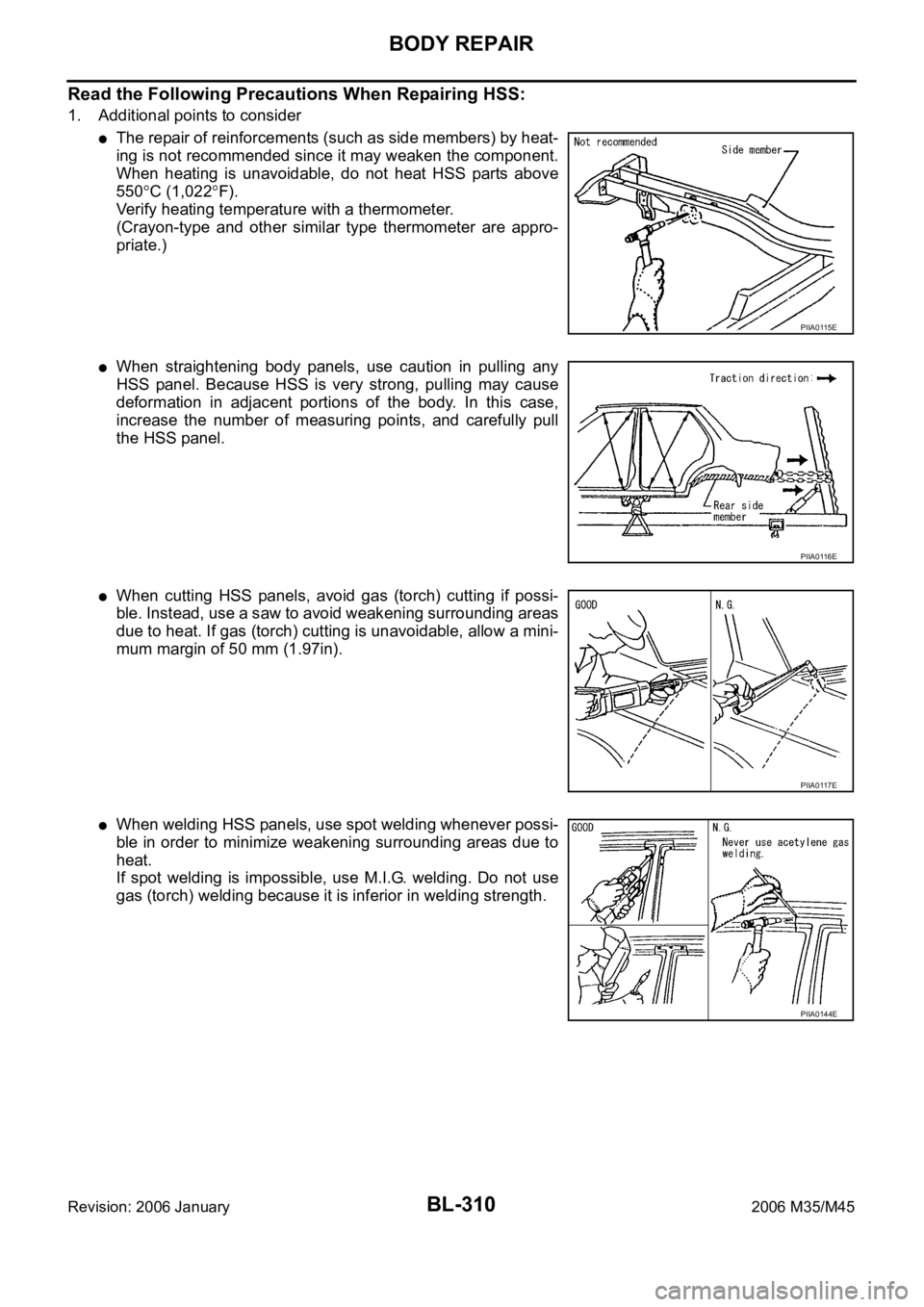2006 INFINITI M35 heating
[x] Cancel search: heatingPage 449 of 5621

ATC-2Revision: 2006 January2006 M35/M45 AUTO SWITCH ................................................... 34
DEFROSTER (DEF) SWITCH ............................. 34
UPPER VENT SWITCH ...................................... 34
A/C SWITCH ....................................................... 35
FAN SWITCHES .................................................. 35
OFF SWITCH ...................................................... 35
REAR WINDOW DEFOGGER SWITCH ............. 35
INTAKE SWITCH ................................................. 35
DUAL SWITCH .................................................... 35
Control Operation (Rear Control Switch) ................ 35
AUTO SWITCH ................................................... 35
FAN SWITCH ...................................................... 35
REAR TEMPERATURE CONTROL SWITCH ..... 35
Fail-Safe Function .................................................. 36
Discharge Air Flow ................................................. 37
System Description ................................................. 38
SWITCHES AND THEIR CONTROL FUNCTION ... 38
CAN Communication System Description .............. 39
TROUBLE DIAGNOSIS ............................................ 40
CONSULT-II Function (ECM) .................................. 40
CONSULT-II BASIC OPERATION ....................... 40
DATA MONITOR .................................................. 40
How to Perform Trouble Diagnosis for Quick and
Accurate Repair ...................................................... 40
WORK FLOW ...................................................... 40
SYMPTOM TABLE .............................................. 41
Component Parts and Harness Connector Location ... 42
ENGINE COMPARTMENT .................................. 42
PASSENGER COMPARTMENT .......................... 43
Schematic ............................................................... 44
Wiring Diagram —A/C— ......................................... 46
Auto Amp. Terminals and Reference Value ............ 53
PIN CONNECTOR TERMINAL LAYOUT ............ 53
TERMINALS AND REFERENCE VALUE FOR
UNIFIED METER AND A/C AMP. ........................ 53
Self-diagnosis Function .......................................... 55
DESCRIPTION .................................................... 55
FUNCTION CONFIRMATION PROCEDURE ...... 56
AUXILIARY MECHANISM: TEMPERATURE
SETTING TRIMMER ........................................... 62
AUXILIARY MECHANISM: FOOT POSITION
SETTING TRIMMER ........................................... 63
AUXILIARY MECHANISM: INLET PORT MEM-
ORY FUNCTION ................................................. 63
Operational Check .................................................. 64
CHECKING MEMORY FUNCTION ..................... 64
CHECKING BLOWER ......................................... 64
CHECKING DISCHARGE AIR (MODE SWITCH
AND DEF SWITCH) ............................................ 64
CHECKING DISCHARGE AIR (UPPER VENT
SWITCH) ............................................................. 65
CHECKING INTAKE AIR ..................................... 65
CHECKING TEMPERATURE DECREASE ......... 65
CHECKING TEMPERATURE INCREASE .......... 65
CHECKING A/C SWITCH ................................... 65
CHECKING AUTO MODE ................................... 65
Power Supply and Ground Circuit for Auto Amp. ... 66
INSPECTION FLOW ........................................... 66
COMPONENT DESCRIPTION ............................ 67DIAGNOSIS PROCEDURE FOR A/C SYSTEM ... 67
Rear Control Switch Circuit ..................................... 69
DIAGNOSIS PROCEDURE FOR REAR CON-
TROL SWITCH .................................................... 69
LAN System Circuit ................................................. 70
DIAGNOSIS PROCEDURE FOR LAN CIRCUIT ... 70
Mode Door Motor Circuit ......................................... 75
INSPECTION FLOW ............................................ 76
SYSTEM DESCRIPTION ..................................... 78
COMPONENT DESCRIPTION ............................ 79
DIAGNOSIS PROCEDURE FOR MODE DOOR
MOTOR ................................................................ 79
Upper Ventilator Door Motor Circuit ........................ 80
INSPECTION FLOW ............................................ 80
SYSTEM DESCRIPTION ..................................... 81
COMPONENT DESCRIPTION ............................ 82
DIAGNOSIS PROCEDURE FOR UPPER VEN-
TILATOR DOOR MOTOR .................................... 82
Air Mix Door Motor Circuit ....................................... 83
INSPECTION FLOW ............................................ 83
SYSTEM DESCRIPTION ..................................... 84
COMPONENT DESCRIPTION ............................ 85
DIAGNOSIS PROCEDURE FOR AIR MIX DOOR
MOTOR ................................................................ 85
Air Mix Door Motor PBR Circuit .............................. 85
DIAGNOSIS PROCEDURE FOR AIR MIX DOOR
MOTOR PBR ....................................................... 85
Intake Door Motor Circuit ........................................ 86
INSPECTION FLOW ............................................ 86
SYSTEM DESCRIPTION ..................................... 87
COMPONENT DESCRIPTION ............................ 88
DIAGNOSIS PROCEDURE FOR INTAKE DOOR
MOTOR ................................................................ 88
Blower Motor Circuit ................................................ 89
INSPECTION FLOW ............................................ 89
SYSTEM DESCRIPTION ..................................... 90
COMPONENT DESCRIPTION ............................ 91
DIAGNOSIS PROCEDURE FOR BLOWER
MOTOR ................................................................ 91
COMPONENT INSPECTION ............................... 93
Magnet Clutch Circuit .............................................. 94
INSPECTION FLOW ............................................ 94
SYSTEM DESCRIPTION ..................................... 95
DIAGNOSIS PROCEDURE FOR MAGNET
CLUTCH .............................................................. 95
COMPONENT INSPECTION ............................... 98
Insufficient Cooling .................................................. 99
INSPECTION FLOW ............................................ 99
PERFORMANCE TEST DIAGNOSIS ................101
PERFORMANCE CHART ..................................103
TROUBLE DIAGNOSIS FOR UNUSUAL PRES-
SURE .................................................................105
DIAGNOSIS PROCEDURE FOR INSUFFI-
CIENT COOLING ...............................................107
Insufficient Heating ...............................................109
INSPECTION FLOW ..........................................109
Noise .....................................................................110
INSPECTION FLOW ..........................................110
Self-Diagnosis ....................................................... 111
Page 488 of 5621

TROUBLE DIAGNOSIS
ATC-41
C
D
E
F
G
H
I
K
L
MA
B
AT C
Revision: 2006 January2006 M35/M45
SYMPTOM TABLE
Symptom Reference Page
A/C system does not come on. Go to Trouble Diagnosis Procedure for A/C System.ATC-66, "
Power
Supply and Ground
Circuit for Auto
Amp."
A/C system cannot be controlled. Go to Multifunction Switch System.AV-108, "
Multifunc-
tion Switch Cannot
Be Operated" (With-
out mobile enter-
tainment system) or
AV-253, "
Multifunc-
tion Switch Cannot
Be Operated" ( Wi t h
mobile entertain-
ment system)
Air outlet does not change.
Go to Trouble Diagnosis Procedure for Mode Door Motor. (LAN)ATC-75, "
Mode
Door Motor Circuit"Mode door motor does not operate normally.
Upper ventilator outlet does not change.
Go to Trouble Diagnosis Procedure for Upper Ventilator Door
Motor. (LAN)ATC-80, "
Upper
Ventilator Door
Motor Circuit"Upper ventilator door motor does not oper-
ate normally.
Discharge air temperature does not change.
Go to Trouble Diagnosis Procedure for Air Mix Door Motor.
(LAN)AT C - 8 3 , "
Air Mix
Door Motor Circuit"Air mix door motor does not operate nor-
mally.
Intake door does not change.
Go to Trouble Diagnosis Procedure for Intake Door Motor. (LAN)AT C - 8 6 , "
Intake
Door Motor Circuit"Intake door motor does not operate nor-
mally.
Blower motor operation is malfunctioning. Go to Trouble Diagnosis Procedure for Blower Motor.ATC-89, "
Blower
Motor Circuit"
Magnet clutch does not engage. Go to Trouble Diagnosis Procedure for Magnet Clutch.AT C - 9 4 , "Magnet
Clutch Circuit"
Insufficient coolingGo to Trouble Diagnosis Procedure for Insufficient Cooling.ATC-99, "
Insufficient
Cooling"
Go to Diagnosis Procedure for Insufficient Cooling.ATC-107, "
DIAG-
NOSIS PROCE-
DURE FOR
INSUFFICIENT
COOLING"
Insufficient heating Go to Trouble Diagnosis Procedure for Insufficient Heating.ATC-109, "Insuffi-
cient Heating"
Noise Go to Trouble Diagnosis Procedure for Noise.AT C - 11 0 , "Noise"
Self-diagnosis cannot be performed. Go to Trouble Diagnosis Procedure for Self-diagnosis.AT C - 111 , "Self-
Diagnosis"
Memory function does not operate. Go to Trouble Diagnosis Procedure for Memory Function.AT C - 11 2 , "Memory
Function"
Rear control switch does not operate. Go to Trouble Diagnosis Procedure for Rear Control Switch.AT C - 6 9 , "Rear Con-
trol Switch Circuit"
Page 512 of 5621

TROUBLE DIAGNOSIS
ATC-65
C
D
E
F
G
H
I
K
L
MA
B
AT C
Revision: 2006 January2006 M35/M45
CHECKING DISCHARGE AIR (UPPER VENT SWITCH)
1. Press temperature control (DOWN) switch (driver side) until 18C (60F) is displayed.
2. Press fan (UP:+) switch until Max. speed.
3. Set MODE switch (driver side) to VENT position.
4. Press UPPER VENT switch.
AUTO indicator should illuminate.
5. Press temperature control (UP) switch (driver side) until 32
C (90F) is displayed.
6. Conform that discharger come out.
7. Press UPPER VENT switch again.
AUTO indicator should OFF.
If NG, go to trouble diagnosis procedure for ATC-80, "
Upper Ventilator Door Motor Circuit" .
If OK, continue the check.
CHECKING INTAKE AIR
1. Press intake switch. Recirculation indicator should illuminate.
2. Press intake switch again. Fresh indicator should illuminate.
3. Listen for intake door position change. (Slight change of blower sound can be heard.)
If NG, go to trouble diagnosis procedure for ATC-86, "
Intake Door Motor Circuit" .
If OK, continue the check.
NOTE:
Confirm that the compressor clutch is engaged (sound or visual inspection) and intake door position is at
FRESH when the D/F or DEF is selected.
CHECKING TEMPERATURE DECREASE
1. Press temperature control (DOWN) switch (driver side) until 18C (60F) is displayed.
2. Check for cold air at discharge air outlets.
If NG, go to trouble diagnosis procedure for ATC-99, "
Insufficient Cooling" .
If OK, continue the check.
CHECKING TEMPERATURE INCREASE
1. Press temperature control (UP) switch (driver side) until 32C (90F) is displayed.
2. Check for hot air at discharge air outlets.
If NG, go to trouble diagnosis procedure for ATC-109, "
Insufficient Heating" .
If OK, continue the check.
CHECKING A/C SWITCH
1. Press AUTO switch and A/C switch.
2. A/C switch indicator will turn ON.
Confirm that the compressor clutch engages (sound or visual inspection).
CHECKING AUTO MODE
1. Press AUTO switch and A/C switch.
2. Display should indicate AUTO.
Discharge air and blower speed will depend on ambient, in-vehicle, and set temperatures.
If NG, go to trouble diagnosis procedure for AT C - 6 6 , "
Power Supply and Ground Circuit for Auto Amp." , then
if necessary, trouble diagnosis procedure for AT C - 9 4 , "
Magnet Clutch Circuit" .
If all operational checks are OK (symptom cannot be duplicated), go to Incident Simulation Tests in GI-28,
"How to Perform Efficient Diagnosis for an Electrical Incident" and perform tests as outlined to simulate driv-
ing conditions environment. If symptom appears, refer to AT C - 4 1 , "
SYMPTOM TABLE" and perform applica-
ble trouble diagnosis procedures.
Page 556 of 5621

TROUBLE DIAGNOSIS
ATC-109
C
D
E
F
G
H
I
K
L
MA
B
AT C
Revision: 2006 January2006 M35/M45
Insufficient HeatingNJS000GW
SYMPTOM: Insufficient heating
INSPECTION FLOW
*1ATC-64, "Operational Check"*2ATC-83, "Air Mix Door Motor Circuit"*3AT C - 5 6 , "FUNCTION CONFIRMA-
TION PROCEDURE", see No. 2 to
6.
*4ATC-56, "
FUNCTION CONFIRMA-
TION PROCEDURE", see No. 13.*5ATC-70, "
LAN System Circuit"*6AT C - 8 9 , "Blower Motor Circuit"
*7EC-226, "DTC P0117, P0118 ECT
SENSOR" (VQ35DE) or EC-948,
"DTC P0117, P0118 ECT SEN-
SOR" (VK45DE)*8CO-11, "
Changing Engine Coolant"
(VQ35DE) or CO-40, "
Changing
Engine Coolant" (VK45DE)*9CO-16, "
Checking Radiator Cap"
(VQ35DE) or CO-45, "
Checking
Radiator Cap" (VK45DE)
RJIA4084E
Page 1249 of 5621

BL-310
BODY REPAIR
Revision: 2006 January2006 M35/M45
Read the Following Precautions When Repairing HSS:
1. Additional points to consider
The repair of reinforcements (such as side members) by heat-
ing is not recommended since it may weaken the component.
When heating is unavoidable, do not heat HSS parts above
550
C (1,022F).
Verify heating temperature with a thermometer.
(Crayon-type and other similar type thermometer are appro-
priate.)
When straightening body panels, use caution in pulling any
HSS panel. Because HSS is very strong, pulling may cause
deformation in adjacent portions of the body. In this case,
increase the number of measuring points, and carefully pull
the HSS panel.
When cutting HSS panels, avoid gas (torch) cutting if possi-
ble. Instead, use a saw to avoid weakening surrounding areas
due to heat. If gas (torch) cutting is unavoidable, allow a mini-
mum margin of 50 mm (1.97in).
When welding HSS panels, use spot welding whenever possi-
ble in order to minimize weakening surrounding areas due to
heat.
If spot welding is impossible, use M.I.G. welding. Do not use
gas (torch) welding because it is inferior in welding strength.
PIIA0115E
PIIA0116E
PIIA0117E
PIIA0144E
Page 1376 of 5621

CO-1
ENGINE COOLING SYSTEM
B ENGINE
CONTENTS
C
D
E
F
G
H
I
J
K
L
M
SECTION CO
A
CO
Revision: 2006 January2006 M35/M45
ENGINE COOLING SYSTEM
VQ35DE
PRECAUTIONS .......................................................... 3
Precautions for Supplemental Restraint System
(SRS) “AIR BAG” and “SEAT BELT PRE-TEN-
SIONER” .................................................................. 3
Precautions for Liquid Gasket .................................. 3
REMOVAL OF LIQUID GASKET SEALING .......... 3
LIQUID GASKET APPLICATION PROCEDURE ..... 3
PREPARATION ........................................................... 5
Special Service Tools ............................................... 5
Commercial Service Tools ........................................ 6
OVERHEATING CAUSE ANALYSIS .......................... 7
Troubleshooting Chart .............................................. 7
COOLING SYSTEM .................................................... 9
Cooling Circuit .......................................................... 9
System Chart ......................................................... 10
ENGINE COOLANT ...................................................11
Inspection ................................................................ 11
LEVEL CHECK .................................................... 11
LEAK CHECK ...................................................... 11
Changing Engine Coolant ....................................... 11
DRAINING ENGINE COOLANT .......................... 11
REFILLING ENGINE COOLANT ........................ 12
FLUSHING COOLING SYSTEM ......................... 13
RADIATOR ................................................................ 14
Components ........................................................... 14
Removal and Installation ........................................ 14
REMOVAL ........................................................
... 14
INSTALLATION ................................................... 16
INSPECTION AFTER INSTALLATION ............... 16
Checking Radiator Cap .......................................... 16
Checking Radiator .................................................. 16
RADIATOR (ALUMINUM TYPE) .............................. 18
Components ........................................................... 18
Disassembly and Assembly ................................... 18
PREPARATION ................................................... 18
DISASSEMBLY ................................................... 18
ASSEMBLY ......................................................... 19
INSPECTION ...................................................... 21COOLING FAN .......................................................... 22
Components ........................................................... 22
Removal and Installation ........................................ 22
REMOVAL ........................................................
... 22
INSTALLATION ................................................... 22
INSPECTION AFTER INSTALLATION ................ 22
Disassembly and Assembly .................................... 23
DISASSEMBLY ................................................... 23
INSPECTION AFTER DISASSEMBLY ................ 23
ASSEMBLY ......................................................... 23
WATER PUMP .......................................................... 24
Components ........................................................... 24
Removal and Installation ........................................ 24
REMOVAL ........................................................
... 24
INSPECTION AFTER REMOVAL ....................... 26
INSTALLATION ................................................... 26
INSPECTION AFTER INSTALLATION ................ 28
WATER INLET AND THERMOSTAT ASSEMBLY .... 29
Components ........................................................... 29
Removal and Installation ........................................ 29
REMOVAL ........................................................
... 29
INSPECTION AFTER REMOVAL ....................... 30
INSTALLATION ................................................... 30
INSPECTION AFTER INSTALLATION ................ 30
WATER OUTLET AND WATER PIPING ................... 31
Components ........................................................... 31
Removal and Installation ........................................ 31
REMOVAL ........................................................
... 31
INSTALLATION ................................................... 32
INSPECTION AFTER INSTALLATION ................ 32
SERVICE DATA AND SPECIFICATIONS (SDS) ...... 33
Standard and Limit .................................................. 33
ENGINE COOLANT CAPACITY (APPROXI-
MATE) .................................................................. 33
RADIATOR .......................................................
... 33
THERMOSTAT .................................................... 33
Page 1377 of 5621

CO-2Revision: 2006 January2006 M35/M45
VK45DE
PRECAUTIONS ......................................................... 34
Precautions for Supplemental Restraint System
(SRS) “AIR BAG” and “SEAT BELT PRE-TEN-
SIONER” ................................................................. 34
PREPARATION ......................................................... 35
Special Service Tools ............................................. 35
Commercial Service Tools ...................................... 35
OVERHEATING CAUSE ANALYSIS ........................ 36
Troubleshooting Chart ............................................ 36
COOLING SYSTEM .................................................. 38
Cooling Circuit ........................................................ 38
System Chart .......................................................... 39
ENGINE COOLANT .................................................. 40
Inspection ............................................................... 40
LEVEL CHECK .................................................... 40
LEAK CHECK ...................................................... 40
Changing Engine Coolant ....................................... 40
DRAINING ENGINE COOLANT .......................... 40
REFILLING ENGINE COOLANT ......................... 41
FLUSHING COOLING SYSTEM ......................... 42
RADIATOR ................................................................ 43
Components ........................................................... 43
Removal and Installation ........................................ 43
REMOVAL ........................................................
... 43
INSTALLATION .................................................... 45
INSPECTION AFTER INSTALLATION ................ 45
Checking Radiator Cap .......................................... 45
Checking Radiator .................................................. 45
RADIATOR (ALUMINUM TYPE) ............................... 47
Components ........................................................... 47
Disassembly and Assembly .................................... 47
PREPARATION ................................................... 47
DISASSEMBLY ................................................... 47
ASSEMBLY ......................................................... 48
INSPECTION ....................................................... 50COOLING FAN .......................................................... 51
Components ............................................................ 51
Removal and Installation ......................................... 51
REMOVAL ............................................................ 51
INSTALLATION .................................................... 51
INSPECTION AFTER INSTALLATION ................ 51
Disassembly and Assembly .................................... 52
DISASSEMBLY .................................................... 52
INSPECTION AFTER DISASSEMBLY ................ 52
ASSEMBLY .......................................................... 52
WATER PUMP ........................................................... 53
Components ............................................................ 53
Removal and Installation ......................................... 53
REMOVAL ............................................................ 53
INSPECTION AFTER REMOVAL ........................ 54
INSTALLATION .................................................... 54
INSPECTION AFTER INSTALLATION ................ 54
THERMOSTAT AND WATER CONTROL VALVE ..... 55
Components ............................................................ 55
Removal and Installation ......................................... 55
REMOVAL ............................................................ 55
INSPECTION AFTER REMOVAL ........................ 56
INSTALLATION .................................................... 56
INSPECTION AFTER INSTALLATION ................ 57
SERVICE DATA AND SPECIFICATIONS (SDS) ...... 58
Standard and Limit .................................................. 58
ENGINE COOLANT CAPACITY (APPROXI-
MATE) .................................................................. 58
RADIATOR ........................................................... 58
THERMOSTAT ..................................................... 58
WATER CONTROL VALVE .................................. 58
Page 1378 of 5621
![INFINITI M35 2006 Factory Service Manual PRECAUTIONS
CO-3
[VQ35DE]
C
D
E
F
G
H
I
J
K
L
MA
CO
Revision: 2006 January2006 M35/M45
[VQ35DE]PRECAUTIONSPFP:00001
Precautions for Supplemental Restraint System (SRS) “AIR BAG” and “SEAT
BELT INFINITI M35 2006 Factory Service Manual PRECAUTIONS
CO-3
[VQ35DE]
C
D
E
F
G
H
I
J
K
L
MA
CO
Revision: 2006 January2006 M35/M45
[VQ35DE]PRECAUTIONSPFP:00001
Precautions for Supplemental Restraint System (SRS) “AIR BAG” and “SEAT
BELT](/manual-img/42/57023/w960_57023-1377.png)
PRECAUTIONS
CO-3
[VQ35DE]
C
D
E
F
G
H
I
J
K
L
MA
CO
Revision: 2006 January2006 M35/M45
[VQ35DE]PRECAUTIONSPFP:00001
Precautions for Supplemental Restraint System (SRS) “AIR BAG” and “SEAT
BELT PRE-TENSIONER”
NBS005RT
The Supplemental Restraint System such as “AIR BAG” and “SEAT BELT PRE-TENSIONER”, used along
with a front seat belt, helps to reduce the risk or severity of injury to the driver and front passenger for certain
types of collision. This system includes seat belt switch inputs and dual stage front air bag modules. The SRS
system uses the seat belt switches to determine the front air bag deployment, and may only deploy one front
air bag, depending on the severity of a collision and whether the front occupants are belted or unbelted.
Information necessary to service the system safely is included in the SRS and SB section of this Service Man-
ual.
WAR NING :
To avoid rendering the SRS inoperative, which could increase the risk of personal injury or death
in the event of a collision which would result in air bag inflation, all maintenance must be per-
formed by an authorized NISSAN/INFINITI dealer.
Improper maintenance, including incorrect removal and installation of the SRS, can lead to per-
sonal injury caused by unintentional activation of the system. For removal of Spiral Cable and Air
Bag Module, see the SRS section.
Do not use electrical test equipment on any circuit related to the SRS unless instructed to in this
Service Manual. SRS wiring harnesses can be identified by yellow and/or orange harnesses or
harness connectors.
Precautions for Liquid GasketNBS004QK
REMOVAL OF LIQUID GASKET SEALING
After removing mounting nuts and bolts, separate the mating
surface using the seal cutter (SST) and remove old liquid gasket
sealing.
CAUTION:
Be careful not to damage the mating surfaces.
Tap the seal cutter to insert it, and then slide it by tapping on the
side as shown in the figure.
In areas where seal cutter is difficult to use, use a plastic ham-
mer to lightly tap the parts, to remove it.
CAUTION:
If for some unavoidable reason tool such as a screwdriver
is used, be careful not to damage the mating surfaces.
LIQUID GASKET APPLICATION PROCEDURE
1. Using a scraper, remove old liquid gasket adhering to the liquid
gasket application surface and the mating surface.
Remove liquid gasket completely from the groove of the liquid
gasket application surface, mounting bolts, and bolt holes.
2. Wipe the liquid gasket application surface and the mating sur-
face with white gasoline (lighting and heating use) to remove
adhering moisture, grease and foreign materials.
PBIC0002E
PBIC0003E